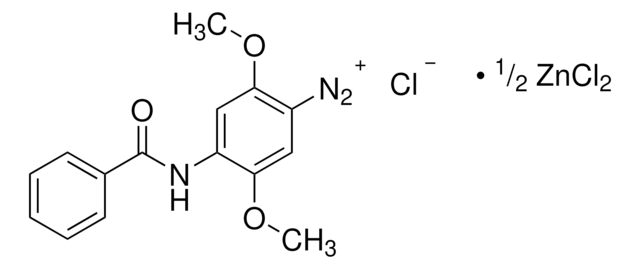202487
Poly(ethylene glycol) methyl ether
average MN 550, methoxy, hydroxyl
동의어(들):
Polyethylene glycol, Methoxy poly(ethylene glycol), Polyethylene glycol monomethyl ether, mPEG
About This Item
추천 제품
product name
Poly(ethylene glycol) methyl ether, average Mn 550
vapor density
>1 (vs air)
vapor pressure
0.05 mmHg ( 20 °C)
형태
semisolid
분자량
average Mn 550
refractive index
n20/D 1.455
점도
7.5 cSt(210 °F)(lit.)
전이 온도
Tm 20 °C
density
1.089 g/mL at 25 °C
Ω-끝
hydroxyl
α-끝
methoxy
InChI
1S/C3H8O2/c1-5-3-2-4/h4H,2-3H2,1H3
InChI key
XNWFRZJHXBZDAG-UHFFFAOYSA-N
유사한 제품을 찾으십니까? 방문 제품 비교 안내
애플리케이션
Poly(ethylene glycol) methyl ether-grafted polyamidoamine (PAMAM) dendrimers can be used as drug carrier systems for anticancer drugs.
Storage Class Code
10 - Combustible liquids
WGK
WGK 1
Flash Point (°F)
359.6 °F - closed cup
Flash Point (°C)
182 °C - closed cup
시험 성적서(COA)
제품의 로트/배치 번호를 입력하여 시험 성적서(COA)을 검색하십시오. 로트 및 배치 번호는 제품 라벨에 있는 ‘로트’ 또는 ‘배치’라는 용어 뒤에서 찾을 수 있습니다.
이미 열람한 고객
문서
Biofouling control essential for device performance and safety; minimize accumulation of biomolecules and bioorganisms.
Progress in biotechnology fields such as tissue engineering and drug delivery is accompanied by an increasing demand for diverse functional biomaterials. One class of biomaterials that has been the subject of intense research interest is hydrogels, because they closely mimic the natural environment of cells, both chemically and physically and therefore can be used as support to grow cells. This article specifically discusses poly(ethylene glycol) (PEG) hydrogels, which are good for biological applications because they do not generally elicit an immune response. PEGs offer a readily available, easy to modify polymer for widespread use in hydrogel fabrication, including 2D and 3D scaffold for tissue culture. The degradable linkages also enable a variety of applications for release of therapeutic agents.
조직 공학과 약물 전달과 같은 생명 공학의 진보는 다양한 기능성 바이오 소재에 대한 수요 증가를 동반합니다. 연구의 집중 관심 대상이 되어온 바이오 소재의 한 분야는 바로 하이드로겔으로, 화학적으로나 물리적으로 세포의 자연 환경과 유사하게 닮아 있기 때문에 세포를 키우는 토대로 사용될 수 있습니다. 본 기술 문서에서는 일반적으로 면역 반응을 유발하지 못하기 때문에 생물학적 용도로 적합한 PEG(폴리에틸렌 글리콜) 하이드로겔에 대해 상세하게 논의합니다. PEG는 쉽게 이용할 수 있으며, 손쉽게 고분자를 수정하여 세포 배양을 위한 2D 및 3D 뼈대를 포함한 하이드로겔 구성에 광범위하게 사용할 수 있습니다. 또한 분해성 결합을 통해 치료제 출시를 위한 다양한 응용분야에도 도움을 줍니다.
Designing biomaterial scaffolds mimicking complex living tissue structures is crucial for tissue engineering and regenerative medicine advancements.
자사의 과학자팀은 생명 과학, 재료 과학, 화학 합성, 크로마토그래피, 분석 및 기타 많은 영역을 포함한 모든 과학 분야에 경험이 있습니다..
고객지원팀으로 연락바랍니다.




